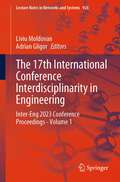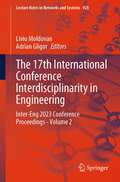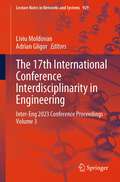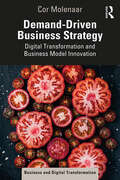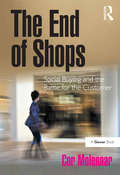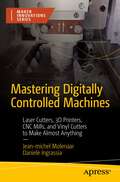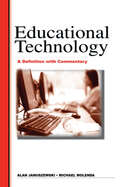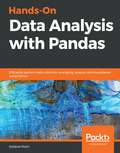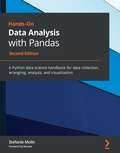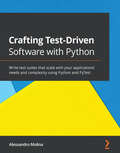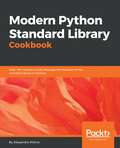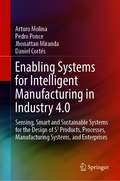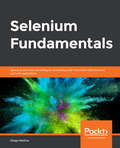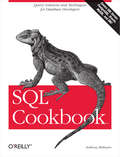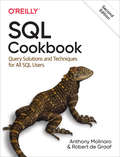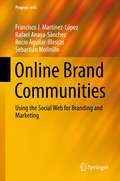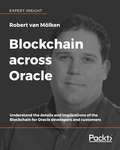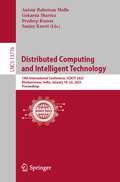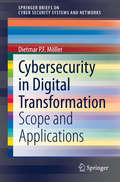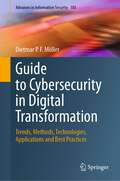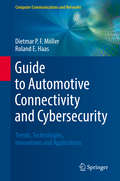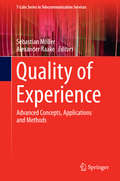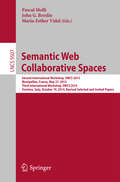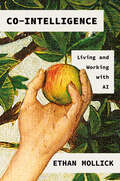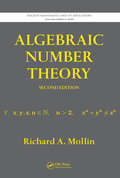- Table View
- List View
The 17th International Conference Interdisciplinarity in Engineering: Inter-Eng 2023 Conference Proceedings - Volume 1 (Lecture Notes in Networks and Systems #926)
by Liviu Moldovan Adrian GligorThis book contains research papers that were accepted for presentation at the 17th International Conference on Interdisciplinarity in Engineering—INTER-ENG 2023, which was held on 5–6 October 2023, in the city of Târgu Mureș, Romania. The general scope of the conference “Towards transition for a more competitive European industry in a smart, safe and sustainable future” is proposing a new approach related to the development of a new generation of smart factories grounded on the manufacturing and assembly process digitalization. It is related to advance manufacturing technology, lean manufacturing, sustainable manufacturing, additive manufacturing, manufacturing tools and equipment. It is a leading international professional and scientific forum of great interest for engineers and scientists who can read in this book research works contributions and recent developments as well as current practices in advanced fields of engineering.
The 17th International Conference Interdisciplinarity in Engineering: Inter-Eng 2023 Conference Proceedings - Volume 2 (Lecture Notes in Networks and Systems #928)
by Liviu Moldovan Adrian GligorThis book contains research papers that were accepted for presentation at the 17th International Conference on Interdisciplinarity in Engineering—INTER-ENG 2023, which was held on 5–6 October 2023, in the city of Târgu Mureș, Romania. The general scope of the conference “Towards transition for a more competitive European industry in a smart, safe and sustainable future” is proposing a new approach related to the development of a new generation of smart factories grounded on the manufacturing and assembly process digitalization. It is related to advance manufacturing technology, lean manufacturing, sustainable manufacturing, additive manufacturing, manufacturing tools and equipment. It is a leading international professional and scientific forum of great interest for engineers and scientists who can read in this book research works contributions and recent developments as well as current practices in advanced fields of engineering.
The 17th International Conference Interdisciplinarity in Engineering: Inter-Eng 2023 Conference Proceedings - Volume 3 (Lecture Notes in Networks and Systems #929)
by Liviu Moldovan Adrian GligorThis book contains research papers that were accepted for presentation at the 17th International Conference on Interdisciplinarity in Engineering—INTER-ENG 2023, which was held on 5–6 October 2023, in the city of Târgu Mureș, Romania. The general scope of the conference “Towards transition for a more competitive European industry in a smart, safe and sustainable future” is proposing a new approach related to the development of a new generation of smart factories grounded on the manufacturing and assembly process digitalization. It is related to advance manufacturing technology, lean manufacturing, sustainable manufacturing, additive manufacturing, manufacturing tools and equipment. It is a leading international professional and scientific forum of great interest for engineers and scientists who can read in this book research works contributions and recent developments as well as current practices in advanced fields of engineering.
Demand-Driven Business Strategy: Digital Transformation and Business Model Innovation (Business and Digital Transformation)
by Cor MolenaarDemand-Driven Business Strategy explains the ways of transforming business models from supply driven to demand driven through digital technologies and big data analytics. The book covers important topics such as digital leadership, the role of artificial intelligence, and platform firms and their role in business model transformation. Students are walked through the nature of supply- and demand-driven models and how organizations transform from one to the other. Theoretical insights are combined with real-world application through global case studies and examples from Amazon, Google, Uber, Volvo and Picnic. Chapter objectives and summaries provide consistent structure and aid learning, whilst reflective questions encourage further thought and discussion. Comprehensive and practical, this is an essential text for advanced undergraduate and postgraduate students studying strategic management, marketing, business innovation, consumer behavior, digital transformation and entrepreneurship.
The End of Shops: Social Buying and the Battle for the Customer
by Cor MolenaarShops are facing tough times: recession, local legislation, parking problems, competition from the internet and the strong position of suppliers. Buying on the Internet 24/7 has become a real alternative to the local shop with its rigid opening hours and limited choice. So is there still a future for the traditional retailer? What are the latest developments in this environment and how can these be translated into significant business models? Cor Molenaar analyses the struggle and the risks to describe the opportunities and potential for the retail trade to turn the tide. He looks at the new buying behaviour of consumers (the new shopping), the evolution of retail (how it used to be, how it is now and what it has to become) and shows what the future for the shop will actually look like. Shops need to change, to reassess their unique customer appeal and work in new ways with suppliers and customers if they are to survive. Online retailing is often seen as the panacea, but is that really the case? The internet will undergo many changes, too. Many e-retailers will disappear or end up surviving on the margin of the mainstream. Only the most canny suppliers and webshops, those that can make best use of the opportunities offered by the Internet will survive.
Mastering Digitally Controlled Machines: Laser Cutters, 3D Printers, CNC Mills, and Vinyl Cutters to Make Almost Anything (Maker Innovations Series)
by Jean-michel Molenaar Daniele IngrassiaTake control of your machine building and production processes with computer-run tools to safely use, or even build, a durable machine for use in your garage or even a startup company. This book provides best practices for laser cutters, 3D printers, CNC mills, vinyl cutters, and more. You'll begin by learning the history of digitally controlled tools, as well as how they work and what materials you can use with them. With this knowledge, you won’t just learn how to make common machines work, you’ll go to the next level and build your own machine—whether that be a plasma cutter or a CNC milling machine.You will learn how they use these tools to create amazing products, art, and even new machines! You’ll also find handy overviews of tools, software, and materials to use in a reference appendix. After reading Mastering Digitally Controlled Machines you’ll be able to create something for yourself, your community, or your company.What You'll LearnUse accessible computer-controlled machines safely to make anything you want to buildFit the right tool and materials with the right projectsBuild your own CNC machine custom tailored to your project’s needs Who This Book Is ForPeople who want to understand how accessible computer-controlled tools work and build any kind of product themselves. Makerspaces, Fab Labs, and similar spaces will benefit. And people who want to create prototypes and products for themselves or their company/ startup, or to start creating prototypes without much prior knowledge.
Educational Technology: A Definition with Commentary
by Michael Molenda Alan JanuszewskiSponsored by the Association for Educational Communications and Technology (AECT), this book presents a definition of the field of study and practice known as educational technology or instructional technology. It reflects the collaborative efforts of all members of the AECT Definition and Terminology Committee. The volume begins with the statement of the definition itself (chapter 1), followed by commentary chapters on each of the key terms and concepts contained in the definition (chapters 2-9). Chapter 10 provides historical context for the current definition by reviewing salient elements of prior AECT definitions. Chapter 11 discusses ethical considerations and chapter 12 concludes by discussing ramifications of the current definition for academic programs in educational technology. This book is appropriate for anyone working in the field of educational technology: students, instructors, researchers and in-service providers.
Hands-On Data Analysis with Pandas: Efficiently perform data collection, wrangling, analysis, and visualization using Python
by Stefanie MolinGet to grips with pandas—a versatile and high-performance Python library for data manipulation, analysis, and discovery Key Features Perform efficient data analysis and manipulation tasks using pandas Apply pandas to different real-world domains using step-by-step demonstrations Get accustomed to using pandas as an effective data exploration tool Book Description Data analysis has become a necessary skill in a variety of positions where knowing how to work with data and extract insights can generate significant value. Hands-On Data Analysis with Pandas will show you how to analyze your data, get started with machine learning, and work effectively with Python libraries often used for data science, such as pandas, NumPy, matplotlib, seaborn, and scikit-learn. Using real-world datasets, you will learn how to use the powerful pandas library to perform data wrangling to reshape, clean, and aggregate your data. Then, you will learn how to conduct exploratory data analysis by calculating summary statistics and visualizing the data to find patterns. In the concluding chapters, you will explore some applications of anomaly detection, regression, clustering, and classification, using scikit-learn, to make predictions based on past data. By the end of this book, you will be equipped with the skills you need to use pandas to ensure the veracity of your data, visualize it for effective decision-making, and reliably reproduce analyses across multiple datasets. What you will learn Understand how data analysts and scientists gather and analyze data Perform data analysis and data wrangling in Python Combine, group, and aggregate data from multiple sources Create data visualizations with pandas, matplotlib, and seaborn Apply machine learning (ML) algorithms to identify patterns and make predictions Use Python data science libraries to analyze real-world datasets Use pandas to solve common data representation and analysis problems Build Python scripts, modules, and packages for reusable analysis code Who this book is for This book is for data analysts, data science beginners, and Python developers who want to explore each stage of data analysis and scientific computing using a wide range of datasets. You will also find this book useful if you are a data scientist who is looking to implement pandas in machine learning. Working knowledge of Python programming language will be beneficial.
Hands-On Data Analysis with Pandas - Second Edition
by Stefanie MolinThis book is for data science beginners, data analysts, and Python developers who want to explore each stage of data analysis and scientific computing using a wide range of datasets. You’ll also find this book useful if you are a data scientist looking to implement pandas in machine learning. Working knowledge of Python programming language will assist with understanding the key concepts covered in this book.
Crafting Test-Driven Software with Python: Write test suites that scale with your applications' needs and complexity using Python and PyTest
by Alessandro MolinaGet to grips with essential concepts and step-by-step explanations to apply TDD practices to your Python projects while keeping your test suite under controlKey FeaturesBuild robust Python applications using TDD and BDD methodologiesTest Python web applications using WebTest and web frameworksLeverage PyTest to implement stringent testing mechanisms to ensure fault-tolerant applicationsBook DescriptionTest-driven development (TDD) is a set of best practices that helps developers to build more scalable software and is used to increase the robustness of software by using automatic tests. This book shows you how to apply TDD practices effectively in Python projects. You'll begin by learning about built-in unit tests and Mocks before covering rich frameworks like PyTest and web-based libraries such as WebTest and Robot Framework, discovering how Python allows you to embrace all modern testing practices with ease. Moving on, you'll find out how to design tests and balance them with new feature development and learn how to create a complete test suite with PyTest. The book helps you adopt a hands-on approach to implementing TDD and associated methodologies that will have you up and running and make you more productive in no time. With the help of step-by-step explanations of essential concepts and practical examples, you'll explore automatic tests and TDD best practices and get to grips with the methodologies and tools available in Python for creating effective and robust applications. By the end of this Python book, you will be able to write reliable test suites in Python to ensure the long-term resilience of your application using the range of libraries offered by Python for testing and development.What you will learnFind out how tests can make your life easier as a developer and discover related best practicesExplore PyTest, the most widespread testing framework for PythonGet to grips with the most common PyTest plugins, including coverage, flaky, xdist, and pickedWrite functional tests for WSGI web applications with WebTestRun end-to-end tests for web applications using Robot FrameworkUnderstand what test-driven development means and why it is importantDiscover how to use the range of tools available in PythonBuild reliable and robust applicationsWho this book is forThis book is for Python developers looking to get started with test-driven development and developers who want to learn about the testing tools available in Python. Developers who want to create web applications with Python and plan to implement TDD methodology with PyTest will find this book useful. Basic knowledge of Python programming is required.
Modern Python Standard Library Cookbook: Over 100 recipes to fully leverage the features of the standard library in Python
by Alessandro MolinaBuild optimized applications in Python by smartly implementing the standard libraryKey FeaturesStrategic recipes for effective application development in PythonTechniques to create GUIs and implement security through cryptographyBest practices for developing readily scalable, production-ready applicationsBook DescriptionThe Python 3 Standard Library is a vast array of modules that you can use for developing various kinds of applications. It contains an exhaustive list of libraries, and this book will help you choose the best one to address specific programming problems in Python.The Modern Python Standard Library Cookbook begins with recipes on containers and data structures and guides you in performing effective text management in Python. You will find Python recipes for command-line operations, networking, filesystems and directories, and concurrent execution. You will learn about Python security essentials in Python and get to grips with various development tools for debugging, benchmarking, inspection, error reporting, and tracing. The book includes recipes to help you create graphical user interfaces for your application. You will learn to work with multimedia components and perform mathematical operations on date and time. The recipes will also show you how to deploy different searching and sorting algorithms on your data.By the end of the book, you will have acquired the skills needed to write clean code in Python and develop applications that meet your needs.What you will learnStore multiple values per key in associative containersCreate interactive character-based user interfacesWork with native time and display data for your time zoneRead/write SGML family languages, both as a SAX and DOM parser to meet file sizes and other requirementsGroup equivalent items using itertools and sorted features togetherUse partials to create unary functions out of multi-argument functionsImplement hashing algorithms to store passwords in a safe wayWho this book is forIf you are a developer who wants to write highly responsive, manageable, scalable, and resilient code in Python, this book is for you. Prior programming knowledge in Python will help you make the most out of the book.
Enabling Systems for Intelligent Manufacturing in Industry 4.0: Sensing, Smart and Sustainable Systems for the Design of S3 Products, Processes, Manufacturing Systems, and Enterprises
by Arturo Molina Pedro Ponce Jhonattan Miranda Daniel CortésThis book introduces the concept of sensing, smart and sustainable systems (S3 systems) to support the design and redesign of products, services, business and manufacturing processes, manufacturing systems, and enterprises. The concept of S3 systems theory is introduced and explained in detail to support designers and engineers in their development task. This approach is embraced in the implementation of emergent Information and communication technologies and artificial intelligence techniques. The text helps the reader to understand the relationship between intelligent manufacturing, S3 systems and Industry 4.0. It presents a review of current approaches to design and development of technology-based products. Finally, it enlarges on the sensing, smart and sustainable systems theory to give examples of S3 systems as case studies.
Selenium Fundamentals: Speed up your internal testing by automating user interaction with browsers and web applications
by Diego MolinaDiscover how to use Selenium to efficiently test your own applications.Key FeaturesUnderstand the importance of automation with real-world examplesExplore each and every path from configuring an environment to automation with Selenium GridMaster the core concepts of Selenium with 40 exercises and 20 activitiesBook DescriptionThere are several challenges while writing automated tests for web applications: you have to select an adequate test framework, use appropriate selectors to avoid flaky tests, and build a good testing framework. Selenium Fundamentals helps you tackle these challenges and provides you with the knowledge to overcome hurdles in testing by developing stable and effective testing solutions. You’ll learn the complete process of automated testing, such as configuring your environment, creating and running automated tests, analyzing reports, and troubleshooting errors by using a Selenium Grid.To start with, you’ll understand the importance of automating tests. You’ll then move on to understanding how to choose the best selectors for navigating through your web applications while highlighting best practices and techniques.After writing your first tests, you’ll cover the object model to create your own advanced test cases. You’ll analyze a test report, track timing errors, and separate real issues from flaky tests. In addition to this, you’ll learn how to configure and connect to a local grid, a network grid, and a third-party service.By the end of the book, you will have the skills you need to run automated tests on your own web applications.What you will learnGet an overview of SeleniumIdentify what to automate in a project and configure the environmentControl browser behavior and manipulate web page elementsUnderstand the nuances of writing tests and creating test suitesCreate UI tests with Selenium WebDriver and analyze test resultsTroubleshoot errors in automation and build meaningful reportingWho this book is forSelenium Fundamentals is designed for you if you are a software quality assurance and development professional who wants to learn how to automate browser activity and web-based user interface tests with Selenium.
SQL Cookbook: Query Solutions and Techniques for Database Developers (Cookbooks (O'Reilly))
by Anthony MolinaroYou know the rudiments of the SQL query language, yet you feel you aren't taking full advantage of SQL's expressive power. You'd like to learn how to do more work with SQL inside the database before pushing data across the network to your applications. You'd like to take your SQL skills to the next level. Let's face it, SQL is a deceptively simple language to learn, and many database developers never go far beyond the simple statement: SELECT columns FROM table WHERE conditions. But there is so much more you can do with the language. In the SQL Cookbook, experienced SQL developer Anthony Molinaro shares his favorite SQL techniques and features. You'll learn about:Window functions, arguably the most significant enhancement to SQL in the past decade. If you're not using these, you're missing outPowerful, database-specific features such as SQL Server's PIVOT and UNPIVOT operators, Oracle's MODEL clause, and PostgreSQL's very useful GENERATE_SERIES functionPivoting rows into columns, reverse-pivoting columns into rows, using pivoting to facilitate inter-row calculations, and double-pivoting a result setBucketization, and why you should never use that term in Brooklyn.How to create histograms, summarize data into buckets, perform aggregations over a moving range of values, generate running-totals and subtotals, and other advanced, data warehousing techniquesThe technique of walking a string, which allows you to use SQL to parse through the characters, words, or delimited elements of a string Written in O'Reilly's popular Problem/Solution/Discussion style, the SQL Cookbook is sure to please. Anthony's credo is: "When it comes down to it, we all go to work, we all have bills to pay, and we all want to go home at a reasonable time and enjoy what's still available of our days." The SQL Cookbook moves quickly from problem to solution, saving you time each step of the way.
SQL Cookbook
by Anthony Molinaro Robert De GraafYou may know SQL basics, but are you taking advantage of its expressive power? This second edition applies a highly practical approach to Structured Query Language (SQL) so you can create and manipulate large stores of data. Based on real-world examples, this updated cookbook provides a framework to help you construct solutions and executable examples in severalflavors of SQL, including Oracle, DB2, SQL Server, MySQL, andPostgreSQL.SQL programmers, analysts, data scientists, database administrators, and even relatively casual SQL users will find SQL Cookbook to be a valuable problem-solving guide for everyday issues. No other resource offers recipes in this unique format to help you tackle nagging day-to-day conundrums with SQL.The second edition includes:Fully revised recipes that recognize the greater adoption of window functions in SQL implementationsAdditional recipes that reflect the widespread adoption of common table expressions (CTEs) for more readable, easier-to-implement solutionsNew recipes to make SQL more useful for people who aren’t database experts, including data scientistsExpanded solutions for working with numbers and stringsUp-to-date SQL recipes throughout the book to guide you through the basics
Online Brand Communities
by Sebastián Molinillo Rocio Aguilar-Illescas Rafael Anaya-Sánchez Francisco J. Martínez-LópezThis book presents and analyzes the concept of online brand communities, an emerging and exciting topic in marketing and eCommerce. First, it lays out the foundations like the evolution of the Web and the so-called Social Web, its utility for users and businesses, and the evolution of the marketing mind-set to adapt the Social Web. On this basis, the book then presents a detailed analysis of online brand communities, examining the concept of virtual community with a specific focus on virtual brand communities. In this context the book also explores recent trends related to branding and brand management. Next, it proposes a classification system for online brand communities, taking into account questions like the motivating factors for consumers to join, participate and stay in a community. The process of value creation in communities is examined from both business and consumer perspectives. The book draws to a close with a brief presentation of the process broadly accepted for the successful development of online brand communities.
Blockchain across Oracle: Understand the details and implications of the Blockchain for Oracle developers and customers
by Robert Van MölkenLearn what the Blockchain is, what the differences between available blockchain platforms are, how to work with Oracle’s Blockchain Cloud Service, and how Blockchain can change the direction of your Oracle work and the focus of your customers.Key FeaturesA professional orientation of the Blockchain for Oracle developers and customersLearn what the Blockchain is and how it will affect for you and your customersLearn how blockchain will disrupt traditional cross-organizational applicationsImplement your own Blockchain on Oracle and develop your first smart contract Industry directions of the Blockchain to help you decide where to develop your skillsBook DescriptionBlockchain across Oracle gives you the professional orientation to Blockchain that you need as an Oracle developer in today’s changing world. Written and prepared for you by Oracle Developer Champion Robert van Mölken, this book gets you up to speed with the details of the Blockchain - core concepts, how to implement Oracle’s Blockchain Cloud Service, industry implications for the Blockchain, and how the Blockchain will affect your Oracle customers.Robert van Mölken introduces you to the history and concepts of the Blockchain. You’ll really get to understand the Blockchain inside and out, as an Oracle developer or solution architect. You’ll understand the Blockchain flow, and how the hashes and chains create a new decentralised paradigm for you as an Oracle developer. You’ll gain insights into how the Blockchain affects Oracle developers and customers in this modern and disruptive era. You’ll see how the Blockchain concepts work in this new world where Assets, Transactions, Security, and Privacy, can all be sustained across a decentralized system for your customers.Then you'll find a detailed look at the cutting-edge Oracle middleware solutions. You’ll learn about Hyperledger Fabric, the opensource Blockchain framework used by Oracle as its core, and how to set up your own Oracle Blockchain Network. You’ll design and develop a smart contract, and learn how to run it on the Oracle Blockchain Cloud Service.The final part of the book looks at how the Blockchain will affect your customers across various industry sectors. By studying industry trends in the financial services sector, healthcare industry, and the transport industry, you’ll discover how the options and possibilities for you and your clients are being transformed by the Blockchain across Oracle. You’ll complete this professional orientation by looking at Blockchain trends and future directions.What you will learnA full introduction to the BlockchainHow the Blockchain affects Oracle developers and customersCore concepts including blocks, hashes, and chains, assets, transactions, and consensusHow to work with Oracle Cloud to implement a Blockchain NetworkDesign, develop, and run smart contracts on the Oracle Blockchain Cloud ServiceBlockchain security and privacy for Oracle developers and clientsPublic and private Blockchain decisions for Oracle architects and developersIndustry analysis across finance, governance, and healthcare sectorsIndustry trends and the future of the Blockchain technologyWho this book is forThis book is a professional orientation for all Oracle developers, solution architects, and decisions makers involved in Oracle system and future development.
Distributed Computing and Intelligent Technology: 19th International Conference, ICDCIT 2023, Bhubaneswar, India, January 18–22, 2023, Proceedings (Lecture Notes in Computer Science #13776)
by Anisur Rahaman Molla Gokarna Sharma Pradeep Kumar Sanjay RawatThis book constitutes the proceedings of the 19th International Conference on Distributed Computing and Intelligent Technology, ICDCIT 2023, which was held in Bhubaneswar, India, in January 2023.The 20 full papers and 9 short papers presented in this volume were carefully reviewed and selected from 55 submissions. The papers are organized in the following topical sections: Invited Talks; Distributed Computing; Intelligent Technology.
Cybersecurity in Digital Transformation: Scope and Applications (SpringerBriefs on Cyber Security Systems and Networks)
by Dietmar P.F. MöllerThis book brings together the essential methodologies required to understand the advancement of digital technologies into digital transformation, as well as to protect them against cyber threat vulnerabilities (in this context cybersecurity attack ontology is included, modeling different types of adversary knowledge). It covers such essential methodologies as CIA Triad, Security Risk, Likelihood, and Consequence Level, Threat Attack Profiling, Threat Intelligence, Threat Lifecycle and more. The idea behind digital transformation is to use digital technologies not only to replicate an existing process in a digital form, but to use digital technology to transform that process into something intelligent (where anything is connected with everything at any time and accessible and controlled and designed advanced). Against this background, cyber threat attacks become reality, using advanced digital technologies with their extreme interconnected capability which call for sophisticated cybersecurity protecting digital technologies of digital transformation.Scientists, advanced-level students and researchers working in computer science, electrical engineering and applied mathematics will find this book useful as a reference guide. Professionals working in the field of big data analytics or digital/intelligent manufacturing will also find this book to be a valuable tool.
Guide to Cybersecurity in Digital Transformation: Trends, Methods, Technologies, Applications and Best Practices (Advances in Information Security #103)
by Dietmar P.F. MöllerIn today’s digital transformation environments, a rigorous cybersecurity approach to effective risk management — including contingency planning, outlining immediate actions, preparing post-breach responses — is central to defending organizations’ interconnected computer systems, networks, and infrastructure resources from malicious cyber-attacks.Specifically, cybersecurity technologies, processes, and practices need to be generalized and applied to intrusion detection and prevention measures. This entails analyzing profiles of cyber-attackers and building cyber-attack models for behavior simulation that can effectively counter such attacks. This comprehensive volume aims to cover all essential aspects of cybersecurity in digital transformation and to provide a framework for considering the many objectives and requirements involved. In addition to introducing theoretical foundations, the work also offers practical techniques for defending against malicious cybercriminals.Topics and features:Explores cybersecurity’s impact on the dynamics of interconnected, complex cyber- and physical systems, infrastructure resources, and networksProvides numerous examples of applications and best practicesConsiders methods that organizations can use to assess their cybersecurity awareness and/or strategyDescribes anomaly intrusion detection, a key tool in thwarting both malware and theft (whether by insiders or external parties) of corporate dataAddresses cyber-attacker profiles, cyber-attack models and simulation, cybersecurity ontology, access-control mechanisms, and policies for handling ransomware attacksDiscusses the NIST Cybersecurity Framework, MITRE Adversarial Tactics, Techniques and Common Knowledge, CIS Critical Security Controls, and the ISA/IEC 62442 Cybersecurity StandardGathering all the relevant information, this practical guide is eminently suitable as a self-study resource for engineers, scientists, computer scientists, and chief information officers. Further, with its many examples of best practices, it can serve as an excellent text for graduate-level courses and research into cybersecurity.Dietmar P. F. Möller, a retired full professor, is affiliated with the Institute for Mathematics at Clausthal University of Technology, Germany. He was an author of several other Springer titles, including Guide to Automotive Connectivity and Cybersecurity.
Guide to Automotive Connectivity and Cybersecurity: Trends, Technologies, Innovations and Applications (Computer Communications and Networks)
by Dietmar P.F. Möller Roland E. HaasThis comprehensive text/reference presents an in-depth review of the state of the art of automotive connectivity and cybersecurity with regard to trends, technologies, innovations, and applications. The text describes the challenges of the global automotive market, clearly showing where the multitude of innovative activities fit within the overall effort of cutting-edge automotive innovations, and provides an ideal framework for understanding the complexity of automotive connectivity and cybersecurity.Topics and features: discusses the automotive market, automotive research and development, and automotive electrical/electronic and software technology; examines connected cars and autonomous vehicles, and methodological approaches to cybersecurity to avoid cyber-attacks against vehicles; provides an overview on the automotive industry that introduces the trends driving the automotive industry towards smart mobility and autonomous driving; reviews automotive research and development, offering background on the complexity involved in developing new vehicle models; describes the technologies essential for the evolution of connected cars, such as cyber-physical systems and the Internet of Things; presents case studies on Car2Go and car sharing, car hailing and ridesharing, connected parking, and advanced driver assistance systems; includes review questions and exercises at the end of each chapter.The insights offered by this practical guide will be of great value to graduate students, academic researchers and professionals in industry seeking to learn about the advanced methodologies in automotive connectivity and cybersecurity.
Quality of Experience
by Sebastian Möller Alexander RaakeThis pioneering book develops definitions and concepts related to Quality of Experience in the context of multimedia- and telecommunications-related applications, systems and services and applies these to various fields of communication and media technologies. The editors bring together numerous key-protagonists of the new discipline "Quality of Experience" and combine the state-of-the-art knowledge in one single volume.
Semantic Web Collaborative Spaces
by Pascal Molli John G. Breslin Maria-Esther VidalThis book constitutes the thoroughly refereedpost-workshop proceedings of the Second International Workshop on Semantic WebCollaborative Spaces, SWCS 2013, held in Montpellier, France, in May 2013, andthe Third International Workshop on Semantic Web Collaborative Spaces, SWCS2014, held in Trentino, Italy, in October 2014. The 6 revised extended papers presented were carefullyreviewed and selected from 10 submissions. The papers are grouped in topicalsections on challenges in collaborative spaces, modeling collaborativecommunities and the role of semantics, semantic MediaWiki communities, andexploiting semantics in collaborative spaces.
Co-Intelligence: Living and Working With AI
by Ethan MollickFrom Wharton professor and author of the popular One Useful Thing Substack newsletter Ethan Mollick comes the definitive playbook for working, learning, and living in the new age of AI <p><p> Something new entered our world in November 2022 — the first general purpose AI that could pass for a human and do the kinds of creative, innovative work that only humans could do previously. Wharton professor Ethan Mollick immediately understood what ChatGPT meant: after millions of years on our own, humans had developed a kind of co-intelligence that could augment, or even replace, human thinking. Through his writing, speaking, and teaching, Mollick has become one of the most prominent and provocative explainers of AI, focusing on the practical aspects of how these new tools for thought can transform our world. <p><p> In Co-Intelligence, Mollick urges us to engage with AI as co-worker, co-teacher, and coach. He assesses its profound impact on business and education, using dozens of real-time examples of AI in action. Co-Intelligence shows what it means to think and work together with smart machines, and why it’s imperative that we master that skill. <p><p> Mollick challenges us to utilize AI’s enormous power without losing our identity, to learn from it without being misled, and to harness its gifts to create a better human future. Wide ranging, hugely thought-provoking, optimistic, and lucid, Co-Intelligence reveals the promise and power of this new era. <p> <b>New York Times Bestseller</b>
Algebraic Number Theory (Discrete Mathematics and Its Applications)
by Richard A. MollinBringing the material up to date to reflect modern applications, this second edition has been completely rewritten and reorganized to incorporate a new style, methodology, and presentation. It offers a more complete and involved treatment of Galois theory, a more comprehensive section on Pollard's cubic factoring algorithm, and more detailed explanations of proofs to provide a sound understanding of challenging material. This edition also studies binary quadratic forms and compares the ideal and form class groups. The text includes convenient cross-referencing, a comprehensive index, and numerous exercises and applications.
